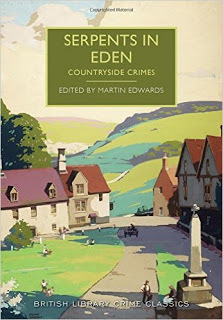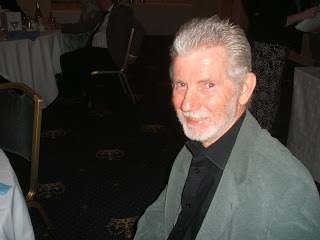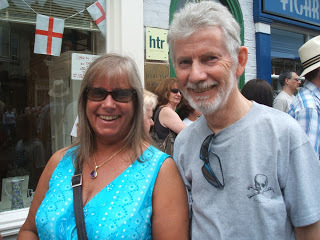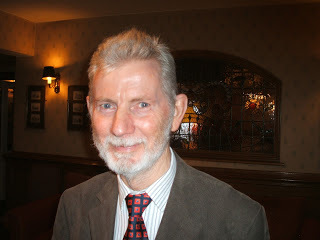Martin Edwards's Blog, page 166
March 7, 2016
The Essex Book Festival

I've just returned from the Essex Book Festival. A long way to go - I set off from snowy Lymm on Friday morning and finished up admiring a rather magical sunset over the water at Southend-on-Sea. But it was a good trip, and I was glad to play a small part in a huge county-wide event that is a credit to those in charge: Seona Ford, Camilla Shestopal, Ros Green, and their various colleagues.
I had the great pleasure of meeting John Simenon, son of the legendary Georges, at a dinner on Friday evening. John has co-produced the imminent new version of Maigret, and was full of admiration for the performance of Rowan Atkinson. Definitely one to look out for. The following morning, I made the short journey to Westcliff to admire the truly fantastic book collection of John Cooper, who co-wrote two of my favourite books about the genre with Barry Pike. One or two items - inscribed books by Georgette Heyer and Henry Wade - stand out in my memory; the former is among the most interesting Golden Age items I've ever seen.
Then it was back to Southend, in time for lunch and then a session moderated by journalist Jake Kerridge in which John Simenon and I enjoyed talking about Golden Age fiction from our different perspectives. An hour and a half sped by. After that, I moderated a panel about international crime fiction. Prior to the Festival, I'd worried about whether I'd be able to do a satisfactory job, given that,the focus of the panellists' books are very different from mine. But one of the great things about crime fiction, I believe, is that the connections between crime novelists, however diverse their writing, are highly positive,and so it proved.
So special thanks to the four people who made up a really excellent panel - see Lucy Dauman's phot above - from which I learned a lot. Leye Adenie is a first time novelist from Nigeria, the grandson of a Nigerian king and - I discovered over a glass or two of his favourite red wine that evening - also an IT expert and creator of patented inventions. We had a fascinating discussion. Robert Karjel is Swedish, and was until recently a Lieutenant Colonel in the Swedish air force. He's written four novels over the past fifteen years or so, and the success of My Name Is N, a thriller with a memorable protagonist, Ernst Grip, has enabled him to concentrate on writing full-time. Robert and I had a chip supper together on the seafront late on Saturday evening in weather conditions that can best be described as "bracing". Zgymunt Miloszeweski is a Polish writer whose books about another interesting central character, called Szacki, have made a big hit. And last but certainly not least was Anya Lipska, a Brit married to Pole whose books about an East End Polish fixer who teams up with a female cop have already won a substantial and enthusiastic following. It was a real pleasure to get to know this quartet of writers, and to be part of a terrific Festival.
Published on March 07, 2016 04:49
March 4, 2016
Forgotten Book - Deadline
Deadline, first published in 1971, introduced journalist Jim Larkin, who proceeded to appear in four more of Martin Russell's novels. Russell had long experience of journalism and makes good use of it in this novel, the most memorable element of which is the vividly conveyed background of a newspaper in an out-of-season seaside resort. .
Larkin's arrival in town coincides with the killing of a young woman, whose body has been decapitated. A second death swiftly follows, and this time the corpse is mutilated even more extensively. Evidently a psychopathic serial killer is on the loose, and Larkin and his colleagues find themselves working flat out as they try to keep up with what reporters nowadays love to describe as "a fast-moving story".
In my twenties, I went through a phase of reading Martin Russell novels, focusing on the stand-alones rather than those featuring Larkin. I was impressed by the twisty plots, which for me compensated for a dearth of characterisation. Russell was a writer who was wise enough to know his limitations, and for twenty years, from 1965 to 1984, he turned out pacy and entertaining mysteries.
My interest in Russell stood me in good stead when Reg Hill, who had written about Russell for the first two editions of Twentieth Century Crime and Mystery Writers, was too busy to update his essay. I was asked to take over, and give Russell's work a fresh look. My views were much the same as Reg's. The plot of Deadline is much less ingenious than those of his best books, or indeed that of Francis Beeding's Death Walks in Eastrepps, another story about multiple murder in a seaside resort. but it's a light, easy read.
Russell was,in the late seventies and early eighties, a prominent figure in the CWA and he also became a member of the Detection Club, but has not had any direct involvement with either organisation for many years. I don't know why he gave up writing so abruptly, but it may be that he felt that his type of crime fiction had become deeply unfashionable, and lost heart. If my guess is correct, I find that rather sad. He may not have been Ruth Rendell, but who was? His books are, as Reg said, both unpretentious and enjoyable.
Larkin's arrival in town coincides with the killing of a young woman, whose body has been decapitated. A second death swiftly follows, and this time the corpse is mutilated even more extensively. Evidently a psychopathic serial killer is on the loose, and Larkin and his colleagues find themselves working flat out as they try to keep up with what reporters nowadays love to describe as "a fast-moving story".
In my twenties, I went through a phase of reading Martin Russell novels, focusing on the stand-alones rather than those featuring Larkin. I was impressed by the twisty plots, which for me compensated for a dearth of characterisation. Russell was a writer who was wise enough to know his limitations, and for twenty years, from 1965 to 1984, he turned out pacy and entertaining mysteries.
My interest in Russell stood me in good stead when Reg Hill, who had written about Russell for the first two editions of Twentieth Century Crime and Mystery Writers, was too busy to update his essay. I was asked to take over, and give Russell's work a fresh look. My views were much the same as Reg's. The plot of Deadline is much less ingenious than those of his best books, or indeed that of Francis Beeding's Death Walks in Eastrepps, another story about multiple murder in a seaside resort. but it's a light, easy read.
Russell was,in the late seventies and early eighties, a prominent figure in the CWA and he also became a member of the Detection Club, but has not had any direct involvement with either organisation for many years. I don't know why he gave up writing so abruptly, but it may be that he felt that his type of crime fiction had become deeply unfashionable, and lost heart. If my guess is correct, I find that rather sad. He may not have been Ruth Rendell, but who was? His books are, as Reg said, both unpretentious and enjoyable.
Published on March 04, 2016 01:00
March 2, 2016
Vanilla Sky - film review
Cameron Crowe's 2001 film Vanilla Sky boasts an impressive cast, led by Tom Cruise, Penelope Cruz and Cameron Diaz. For good measure, Timothy Spall is cast as a British lawyer; I've recently watched Spall making a superb job of the title role in Mike Leigh's interesting, if possibly over-long film about my favourite artist, Turner: he really is a fine actor.
This film is hard to classify: some describe it as a psychological thriller, but it also veers into sci-fi territory as the plot thickens. It certainly has a touch of originality about it, and that's always welcome. Cruise plays David Aames, a fabulously wealthy young publisher, who has inherited control of a vast business empire, but is menaced by a group of seven grumpy old board members. Cruise is involved with Diaz, who is much more serious about their relationship than he is, and soon he takes a shine to his best friend's new girl (Cruz). Intercut with these sequences are later scenes which reveal that Cruise has been disfigured in an accident, and stands accused of murder. What on earth happened to turn his world upside down?
I found this premise intriguing, but although there were quite a few plot twists, (and several rather creepy moments) I became rather frustrated by the sluggish narrative pace. If Turner was arguably over-long, then I don''t think there's much doubt in this case - Vanilla Sky, it seems to me, would be much more gripping if cut by at least half an hour. Probably three-quarters of an hour. There's a portentousness about the script, it seems to me, which isn't entirely justified, much though I admire ambitious writing. Overall, I felt that the "psychology" was not as sophisticated as the film-makers seemed to believe; nor was the story as consistently thrilling as I'd hoped.
But that can happen when you dare to do something different. Perhaps the excellence of the cast gave me unreasonably high expectations. Despite my reservations, Vanilla Sky is well-made, and well worth watching, not least for a very good soundtrack featuring Nancy Wilson, Paul McCartney,the Beach Boys et al.
This film is hard to classify: some describe it as a psychological thriller, but it also veers into sci-fi territory as the plot thickens. It certainly has a touch of originality about it, and that's always welcome. Cruise plays David Aames, a fabulously wealthy young publisher, who has inherited control of a vast business empire, but is menaced by a group of seven grumpy old board members. Cruise is involved with Diaz, who is much more serious about their relationship than he is, and soon he takes a shine to his best friend's new girl (Cruz). Intercut with these sequences are later scenes which reveal that Cruise has been disfigured in an accident, and stands accused of murder. What on earth happened to turn his world upside down?
I found this premise intriguing, but although there were quite a few plot twists, (and several rather creepy moments) I became rather frustrated by the sluggish narrative pace. If Turner was arguably over-long, then I don''t think there's much doubt in this case - Vanilla Sky, it seems to me, would be much more gripping if cut by at least half an hour. Probably three-quarters of an hour. There's a portentousness about the script, it seems to me, which isn't entirely justified, much though I admire ambitious writing. Overall, I felt that the "psychology" was not as sophisticated as the film-makers seemed to believe; nor was the story as consistently thrilling as I'd hoped.
But that can happen when you dare to do something different. Perhaps the excellence of the cast gave me unreasonably high expectations. Despite my reservations, Vanilla Sky is well-made, and well worth watching, not least for a very good soundtrack featuring Nancy Wilson, Paul McCartney,the Beach Boys et al.
Published on March 02, 2016 02:05
February 29, 2016
Serpents in Eden and other British Library Crime Classics

The British Library is responding to reader demand by continuing to publish a diverse range of titles in its Crime Classics series. The latest John Bude book, Death on the Riviera, which is in my opinion highly enjoyable, is selling tremendously well, while my anthology Murder at the Manor is also going great guns. The next anthology in the series, Serpents in Eden, is now out, and here I've gathered together stories about crime in the countryside. Some great writers features - Conan Doyle, E.C. Bentley, Margery Allingham and the under-valued H.C. Bailey among them. And there are also some less familiar names, including Leonora Wodehouse - yes, the daughter of the legendary P.G....
I'd also like to mention two other novelists whose work is due to appear in the series shortly. The first is Miles Burton, one of the aliases of Major John Cecil Street - crime fans know him best as the ultra-prolific John Rhode. The BL have opted to publish two of his stories about Desmond Merrion - The Secret of High Eldersham and Death in the Tunnel.
A writer who was, I have to confess,previously unknown to me before the BL identified his potential is John Rowland. He usually wrote about Inspector Shelley, who features in Murder in the Museum and Calamity in Kent. In writing my introductions to the books, I benefited greatly from information supplied by Fytton Rowland, son of the author, and I discovered that Rowland was an interesting chap whose other writing included a tribute to Eden Philpotts and a number of true crime books -including a significant study of the Wallace case.
There's plenty more to come in the second half of the year, including another anthology, and a book that has a quite unique dimension; I'm especially excited about the latter project. At present, my lips are sealed, but all will be revealed before too long!
Published on February 29, 2016 10:19
February 26, 2016
Forgotten Book - The Ponson Case
The Detective Story Library imprint of Harper Collins has revived several fascinating titles, including some of my favourites. The Rasp by Philip MacDonald, which has an excellent intro by Tony Medawar, is an example. But Freeman Wills Crofts' second book, The Ponson Case, is a mystery I'd never read until I read the DSL reprint. This nicely presented reissue benefits from an intro by crime novelist Dolores Gordon Smith, who talked about Crofts at last year's hugely successful Bodies in the Library conference.
Dolores tells a story about Crofts' meticulous approach to the plotting of this novel, which was a follow-up to his best-selling debut The Cask. He spent three hours persuading his publishers that he had researched the plot detail with intense attention to detail. And this shows in the book, although I have to say the result is not totally gripping. There's a nice description of an English country house at the start of the book, but once the body of Sir William Ponson is discovered in the river, the focus is on alibis, and how to crack them.
Crofts ditched Inspector Burnley, who took the lead in The Cask, and introduced the equally painstaking Inspector Tanner. A sketch map of the scene of the crime is supplied, and Tanner ventures as far as Portugal in search of the truth about Ponson's death. But there is a shortage of suspects, a failing of several Golden Age novels. Why is it a failing? Because the characters are not explored in enough depth to compensate for the limited nature of the mystery.
Eventually Tanner gets to the truth, but it turns out to be rather anti-climactic, to say the least. But I'm really glad I read it, and not only because it filled a gap in my knowledge of Crofts' writing. What we have here is a book which shows a capable crime writer at the start of his career, trying to do something unusual in genre terms to build on the conspicuous success of his debut novel. It was this determination not to get stuck in a rut (despite his long-term fondness for alibi puzzles) that set Crofts apart from lesser writers. If you look at his inverted novels, such as Antidote to Venom, you see how keen he was to experiment, and that same freshness of approach is the most notable feature of The Ponson Case..A welcome reprint, then, which has given me a better understanding of Crofts' approach to his craft.
Dolores tells a story about Crofts' meticulous approach to the plotting of this novel, which was a follow-up to his best-selling debut The Cask. He spent three hours persuading his publishers that he had researched the plot detail with intense attention to detail. And this shows in the book, although I have to say the result is not totally gripping. There's a nice description of an English country house at the start of the book, but once the body of Sir William Ponson is discovered in the river, the focus is on alibis, and how to crack them.
Crofts ditched Inspector Burnley, who took the lead in The Cask, and introduced the equally painstaking Inspector Tanner. A sketch map of the scene of the crime is supplied, and Tanner ventures as far as Portugal in search of the truth about Ponson's death. But there is a shortage of suspects, a failing of several Golden Age novels. Why is it a failing? Because the characters are not explored in enough depth to compensate for the limited nature of the mystery.
Eventually Tanner gets to the truth, but it turns out to be rather anti-climactic, to say the least. But I'm really glad I read it, and not only because it filled a gap in my knowledge of Crofts' writing. What we have here is a book which shows a capable crime writer at the start of his career, trying to do something unusual in genre terms to build on the conspicuous success of his debut novel. It was this determination not to get stuck in a rut (despite his long-term fondness for alibi puzzles) that set Crofts apart from lesser writers. If you look at his inverted novels, such as Antidote to Venom, you see how keen he was to experiment, and that same freshness of approach is the most notable feature of The Ponson Case..A welcome reprint, then, which has given me a better understanding of Crofts' approach to his craft.
Published on February 26, 2016 02:39
February 25, 2016
Stuart Pawson R.I.P.

My friend and fellow crime writer Stuart Pawson has died, and in sharing this very sad news, I want to pay tribute to one of life's nice guys, a quiet, kind man who also happened to be a terrific writer. If you haven't read his novels, I can most definitely recommend them.
I got to know Stuart shortly after his first book was published by Headline. We met through the Northern Chapter of the CWA - where I've met so many lovely people over the years - and he proved a great companion, always aided and abetted by his devoted wife Doreen. When Margaret Murphy formed the Murder Squad collective of writers in 2000, Stuart and I were founder members, and we took part in a wide range of enjoyable events together. I have an especially vivid memory of Stuart reading, in his deadpan way, a very funny and quite raunchy scene to the (seemingly) staid ladies of Knutsford,and receiving a rapturous response.
He was a very witty guy, and because he was also very retiring, his humour packed even more of a punch. He, Doreen and I spent about a week together at a memorable Bouchercon in Las Vegas - was it really thirteen years ago? - and travelled around in the area - a drive through the desert to the Hoover Dam sticks in my mind as a really fun day out. This is a photo Doreen took of the pair of us on the journey, and it brings back happy memories...

Stuart's dry wit and his love of Yorkshire make his books about Charlie Priest - there are thirteen of them - not only entertaining but also distinctive. Once in a while I talked him into writing short stories, and they too are highly enjoyable. One sad day came, though, when Stuart phoned me and broke the news that Parkinson's had been diagnosed. At that point, he didn't want it to become public knowledge,and he did keep writing for a while, as well as travelling the world with Doreen on one cruise after another.

Eventually, however, the time came when writing was no longer his priority. He resigned from Murder Squad, although he continued to attend CWA lunches at Boroughbridge every now and then. I last saw him there, and he was very frail, but the trademark humour was exactly as it had always been,
I'll miss Stuart a lot. For me, as I say, there are many personal memories to cherish. For all of us, he leaves a legacy of accomplished crime writing that will be appreciated for many years to come.

Published on February 25, 2016 08:00
February 24, 2016
The Franchise Affair - film review
The Franchise Affair is a 1951 film closely based on Josephine Tey's excellent novel. It offers a crime story, but not a murder mystery. Rather, the puzzle is based on the real life Elizabeth Canning case. A girl accuses a woman and her grumpy old mother of kidnapping her, and forcing her to become their servant. The accused women call in a local solicitor, Robert Blair, to defend them.
It's a low-key premise, one which is, I think, better suited to a book than a film, because it's not an obviously dramatic situation, despite a courtroom scene (in which the key twist comes rather out of the blue - a flaw in the writing). That said, I found The Franchise Affair to be a good example of the "well-make" post-war British film, with good performances from an excellent cast who make the most of the story's potential.
Michael Denison plays Blair, one of those small town solicitors from the Good Old Days, when you could take on a client without worrying about letters of engagement, or compliance with the anti money laundering legislation. Nor does he have to bother with computerised time recording, or targets for chargeable hours, lucky fellow. This freedom enables him to take on a case for which he's not really equipped in terms of experience. But determination sees him through.
Marion Sharp is played by Dulcie Gray, who was Denison's wife in real life. She was also a writer of mystery stories. As it happens, I've recently bought one of her books, and look forward to reading it. The remaining cast includes such future stars as Kenneth More (later Father Brown) and Patrick Troughton (a future Doctor Who). All in all, I enjoyed this film. I watched it the day after watching the much more dramatic The Shining. But in its quiet and unambitious way, it was equally entertaining.
It's a low-key premise, one which is, I think, better suited to a book than a film, because it's not an obviously dramatic situation, despite a courtroom scene (in which the key twist comes rather out of the blue - a flaw in the writing). That said, I found The Franchise Affair to be a good example of the "well-make" post-war British film, with good performances from an excellent cast who make the most of the story's potential.
Michael Denison plays Blair, one of those small town solicitors from the Good Old Days, when you could take on a client without worrying about letters of engagement, or compliance with the anti money laundering legislation. Nor does he have to bother with computerised time recording, or targets for chargeable hours, lucky fellow. This freedom enables him to take on a case for which he's not really equipped in terms of experience. But determination sees him through.
Marion Sharp is played by Dulcie Gray, who was Denison's wife in real life. She was also a writer of mystery stories. As it happens, I've recently bought one of her books, and look forward to reading it. The remaining cast includes such future stars as Kenneth More (later Father Brown) and Patrick Troughton (a future Doctor Who). All in all, I enjoyed this film. I watched it the day after watching the much more dramatic The Shining. But in its quiet and unambitious way, it was equally entertaining.
Published on February 24, 2016 04:30
February 22, 2016
The Agatha Awards - and a trip to remember
I returned recently from a wonderful trip to Central and South America, and while I was away, the news was announced that The Golden Age of Murder is among the titles nominated for an Agatha Award at Malice Domestic this year. There are some fine writers among the nominees, and it's flattering to be in their company. None of my novels or short stories has been nominated for any American award until recently. Yet in late April, this book will be in the running for two awards in the space of seventy-two hours. A weird quirk of fate, and very gratifying.
I'm interested to see that The Golden Age of Murder is the only title common to the shortlists for both the Edgar awarded by the Mystery Writers of America, and the Agatha Award. This illustrates the growing number and range of critical/biographical books related to crime fiction. Not so long ago, I could claim to have read a majority of books about the genre - now I'm struggling to keep up. It's a good thing, surely, that crime fiction is now deemed a worthy subject of study, in book form as well as in countless blogs and social media groups.
I've also heard from the publishers that demand for the hardback edition of the book continues to exceed expectations. This is due, in part at least, I think, to the fact that Harper Collins have done such a good production job, so that many people think it's a really nice volume to have on the shelves. As a result, the paperback edition is, at least in the UK, likely to be postponed for a while. It may appear later this year, or possibly next year. Suffice to say that I never expected that my best-selling hardback would prove to be a book about the Detection Club....
Anyway, a few words now about that magical trip, which took me back to Jamaica and then to three countries I'd never visited, before. In Costa Rica, there was a chance of a river cruise through the jungle, and a close look at fascinating wild life, not least an alligator lurking just below the surface of the water...

In Panama, one can cross from the Atlantic coast to the Pacific in an hour: a fascinating trip. There's a lot of history (along with lots of skyscrapers) to be seen in Panama City, including an old ruined cathedral, and much else besides...



Colombia was absolutely fascinating. Cartagena is a gorgeous place, oozing with history..

while Santa Marta, again on the coast, offers a mix of fabulous wildlife, in the gardens which celebrate the legendary Simon Bolivar (who died there) and also on the beach..........


As ever, I seized the opportunity to combine sight-seeing with plenty of reading. And the fruits of that reading will be revealed soon, with a number of new entries in the Forgotten Books series.

.
I'm interested to see that The Golden Age of Murder is the only title common to the shortlists for both the Edgar awarded by the Mystery Writers of America, and the Agatha Award. This illustrates the growing number and range of critical/biographical books related to crime fiction. Not so long ago, I could claim to have read a majority of books about the genre - now I'm struggling to keep up. It's a good thing, surely, that crime fiction is now deemed a worthy subject of study, in book form as well as in countless blogs and social media groups.
I've also heard from the publishers that demand for the hardback edition of the book continues to exceed expectations. This is due, in part at least, I think, to the fact that Harper Collins have done such a good production job, so that many people think it's a really nice volume to have on the shelves. As a result, the paperback edition is, at least in the UK, likely to be postponed for a while. It may appear later this year, or possibly next year. Suffice to say that I never expected that my best-selling hardback would prove to be a book about the Detection Club....
Anyway, a few words now about that magical trip, which took me back to Jamaica and then to three countries I'd never visited, before. In Costa Rica, there was a chance of a river cruise through the jungle, and a close look at fascinating wild life, not least an alligator lurking just below the surface of the water...

In Panama, one can cross from the Atlantic coast to the Pacific in an hour: a fascinating trip. There's a lot of history (along with lots of skyscrapers) to be seen in Panama City, including an old ruined cathedral, and much else besides...



Colombia was absolutely fascinating. Cartagena is a gorgeous place, oozing with history..

while Santa Marta, again on the coast, offers a mix of fabulous wildlife, in the gardens which celebrate the legendary Simon Bolivar (who died there) and also on the beach..........


As ever, I seized the opportunity to combine sight-seeing with plenty of reading. And the fruits of that reading will be revealed soon, with a number of new entries in the Forgotten Books series.

.
Published on February 22, 2016 02:58
February 21, 2016
Television Writing: Shetland, Dickensian, and War and Peace
I've been following a number of well-crafted TV series lately, including War and Peace and the soap opera-like Dickensian, which finally comes to an end this evening, though I gather a second series may be planned. War and Peace was quite brilliantly adapted by Andrew Davies. His scripts seem to me to offer a masterclass in economical writing; you could say that he's the TV writing equivalent of a Len Deighton or an Elmore Leonard. I have also continued to watch Shetland, which - as I mentioned here a while ago - got off to a very good start.
I hadn't realised that this series of Shetland was to involve a single story stretched over six episodes, and this structure has cons as well as pros. However, the added length has given the writers the chance to address a number of issues, above all the effect of the rape of one of the central characters. Ann Cleeves has written an eloquent article about this aspect of the story in The Guardian which I think raises some important questions about the portrayal of violence in crime fiction, and deserves a wide readership.
Quite apart from this, the series has made clear to me what a fine actor Douglas Henshall is. He has the knack of conveying a considerable range of emotions with great economy, (you'll have gathered that I'm an admirer of economy!) and I've been increasingly impressed by his performance. Originally, he didn't fit my idea of Jimmy Perez, but he's definitely won me over.
Shetland has held my attention from the first episode, and credit must go to the main writer, Gaby Chiappe. The story is more like a thriller rather than a detective story, complete with a somewhat stereotypical gangland villain, and it has seemed rather meandering at times. It could be argued that, sensitively as the rape sub-plot is handled, the rape itself was largely superfluous to the plot, though whether that is so or not won't be clear until we've seen the final episode.
Possibly six episodes was one or two too many; the same issue arises even more acutely with Dickensian.,which has occasionally dragged. Overall, though, like Dickensian, it makes very good television, and if you haven't watched the shows this time around, it's definitely worth looking out for the repeats or the DVDs. As for War and Peace, until recently I've never felt a burning desire to read Tolstoy. But Davies' wonderful writing has made me realise that I've been missing out..
I hadn't realised that this series of Shetland was to involve a single story stretched over six episodes, and this structure has cons as well as pros. However, the added length has given the writers the chance to address a number of issues, above all the effect of the rape of one of the central characters. Ann Cleeves has written an eloquent article about this aspect of the story in The Guardian which I think raises some important questions about the portrayal of violence in crime fiction, and deserves a wide readership.
Quite apart from this, the series has made clear to me what a fine actor Douglas Henshall is. He has the knack of conveying a considerable range of emotions with great economy, (you'll have gathered that I'm an admirer of economy!) and I've been increasingly impressed by his performance. Originally, he didn't fit my idea of Jimmy Perez, but he's definitely won me over.
Shetland has held my attention from the first episode, and credit must go to the main writer, Gaby Chiappe. The story is more like a thriller rather than a detective story, complete with a somewhat stereotypical gangland villain, and it has seemed rather meandering at times. It could be argued that, sensitively as the rape sub-plot is handled, the rape itself was largely superfluous to the plot, though whether that is so or not won't be clear until we've seen the final episode.
Possibly six episodes was one or two too many; the same issue arises even more acutely with Dickensian.,which has occasionally dragged. Overall, though, like Dickensian, it makes very good television, and if you haven't watched the shows this time around, it's definitely worth looking out for the repeats or the DVDs. As for War and Peace, until recently I've never felt a burning desire to read Tolstoy. But Davies' wonderful writing has made me realise that I've been missing out..
Published on February 21, 2016 07:28
February 19, 2016
Forgotten Book - Murder by Burial
Murder by Burial (1938), my Forgotten Book for today, is the one and only crime novel published by Stanley Casson. The novel was published in the US as well as in the author's native UK,and was also an early green Penguin paperback, a successful track record for a new crime writer (although he published a range of non-fiction books). So why did Casson never write another mystery?
Part of the reason may be that, although this book offers a great deal of interest, it is not a strong mystery. Casson took the basic idea from a real life accident (not a crime) involving two fellow archaeologists,but really the concept strikes me as better suited to a clever "howdunit" type of short story rather than a full length novel. There's quite a lot of padding as Casson shares his thoughts about politics - the previous year, he'd published a rather gloomy book called Progress and Catastrophe.
But another explanation is that Casson died just six years after the book was published. He was only 54, but he was serving as a Lieutenant-Colonel in the Intelligence Corps - having previously fought with distinction in the First World War. He died on active service, not long after having escaped from the Nazis while serving in Europe. Obviously a brave man, and undoubtedly a man of great talent. Amongst other things, he was an archaeology don at New College, a colleague of the legendary Reverend Spooner.
The story is a simple one, but it's told amusingly and written well. A retired colonel sets up an organisation to extol the glories of the Roman influence on Britain, but soon the movement is hi-jacked for Fascist purposes. A local canon and his pretty young woman friend become involved in an archaeological excavation, but the canon falls out with the colonel, with fatal consequences. An unusual story, and certainly worth seeking out, despite its flaws.
Part of the reason may be that, although this book offers a great deal of interest, it is not a strong mystery. Casson took the basic idea from a real life accident (not a crime) involving two fellow archaeologists,but really the concept strikes me as better suited to a clever "howdunit" type of short story rather than a full length novel. There's quite a lot of padding as Casson shares his thoughts about politics - the previous year, he'd published a rather gloomy book called Progress and Catastrophe.
But another explanation is that Casson died just six years after the book was published. He was only 54, but he was serving as a Lieutenant-Colonel in the Intelligence Corps - having previously fought with distinction in the First World War. He died on active service, not long after having escaped from the Nazis while serving in Europe. Obviously a brave man, and undoubtedly a man of great talent. Amongst other things, he was an archaeology don at New College, a colleague of the legendary Reverend Spooner.
The story is a simple one, but it's told amusingly and written well. A retired colonel sets up an organisation to extol the glories of the Roman influence on Britain, but soon the movement is hi-jacked for Fascist purposes. A local canon and his pretty young woman friend become involved in an archaeological excavation, but the canon falls out with the colonel, with fatal consequences. An unusual story, and certainly worth seeking out, despite its flaws.
Published on February 19, 2016 04:19



